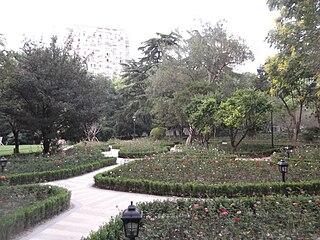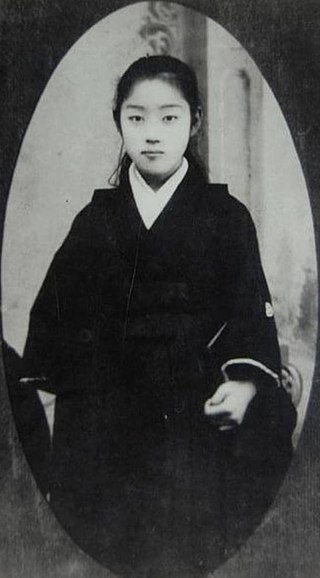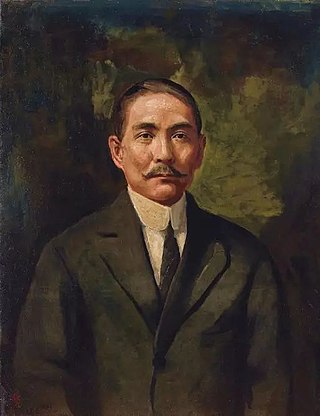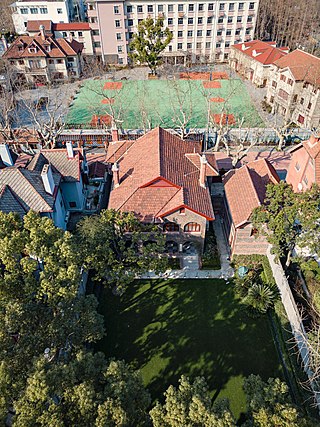
Sun Yat-sen was a Chinese revolutionary, statesman, and political philosopher who served as the provisional first president of the Republic of China and the first leader of the Kuomintang (KMT). Uniquely among 20th-century Chinese leaders, Sun is revered by both the Republic of China on Taiwan and by the People's Republic of China for his instrumental role in the 1911 Revolution that successfully overthrew the Qing dynasty.

Zhongshan alternately romanized via Cantonese as Chungshan is a prefecture-level city in the south of the Pearl River Delta in Guangdong province, China. As of the 2020 census, the whole city with 4,418,060 inhabitants is now part of the Guangzhou–Shenzhen conurbation with 65,565,622 inhabitants. The city-core subdistricts used to be called Shiqi or Shekki.

Cuiheng is a village of the town of Nanlang, Zhongshan, Guangdong province. Cuiheng is best known as the birthplace of Dr. Sun Yat-sen, the "Father of the Nation" of the Republic of China. Cuiheng is 17.6 kilometres (10.9 mi) southeast of downtown Zhongshan, and 26 km (16 mi) north of Macau. The whole village is designated a special economic district, as Cuiheng New Area.

Xiangshan County, also spelled Hsiangshan, Siangshan, Heungsan, and Heungshan, was a former county in Southern China. From 1912, it was a county in Guangdong Province, in the Republic of China. It was renamed Zhongshan in April 1925, in honor of the founder of the Republic of China, Sun Yat Sen, a Xiangshan native.

Sun Yat-sen University is a public research university in Guangzhou, Guangdong, China. It is affiliated with the Ministry of Education, and co-funded by the Ministry of Education, SASTIND, and Guangdong Provincial Government. The university is part of Project 211, Project 985, and the Double First-Class Construction.

Sun Yat-sen's Mausoleum is situated at the foot of the second peak of Purple Mountain in Nanjing, Jiangsu, China. Construction of the tomb started in January 1926, and was finished in spring of 1929. The architect was Lü Yanzhi, who died shortly after it was finished. His representative and project partner was his close friend Huang Tanpu.
Zhongshan (中山市) is a prefecture-level city in Guangdong province, People's Republic of China.
Zhongshan Park is a common name for Chinese parks, in honour of Sun Yat-sen, better-known in Chinese as Sun Zhongshan, who is considered by many to be the "Father of modern China". Currently there are more than 40 Zhongshan Parks in China, and some in overseas areas.

Zhongshan Park, formerly called Jessfield Park and Zhaofeng Park, is a park in Changning District, Shanghai, China. The park has a large collection of trees and flowers. People fly kites and play sport games on the large meadow areas.

Sun Yat-sen House is located in the South Garden of Gulou Campus of Nanjing University in Nanjing, Jiangsu, China. It's said that Sun Yat-sen, the first president of the Republic of China, lived there in 1910s.
中山 is an East Asian name composed of two characters which collectively mean "central mountain". 中山 may refer to:

Chebei Station is a station of Guangzhou Metro Line 4. It is located at the underground of the junction of Chebei Road and Zhongshan Avenue in Tianhe District. It started operation on 25 September 2010.

The Sun Yat Sen High School of Iloilo, Inc. is a private, Chinese preparatory school at Mapa St., Iloilo City administered by its board of trustees. Its programs are in Chinese and English. Filipino subjects and subjects required by the Department of Education of the Philippines are categorized under the English subjects.

Kaoru Otsuki was a Japanese woman known for being the second wife of Sun Yat-sen, the founder and first president of the Republic of China.

This is a family tree of Sun Yat-sen, the first provisional president of the Republic of China. The following chart uses Mandarin pinyin romanization. Some members may have been referred to in the Cantonese, Hakka, Hokkien at one time or another. Pre-marriage surnames are used.

Luo Xianxiang (1890–1968) was a World War II Chinese general who served in the army of Chen Jiongming. He was a soldier, and at times, a regional government official. He established anti-corruption policies and conducted administrative and education reforms.

The Former Residence of Sun Yat-sen, located at 7 Xiangshan Road in the French Concession area of Shanghai, China, near Fuxing Park to the east, was the residence of the Chinese revolutionary Dr. Sun Yat-sen (1866–1925).

The Nanking Provisional Government cabinet, also known as the Sun Yat-sen cabinet, was a temporary cabinet of the republican era of China. The first cabinet assembled following the formation of the Provisional Government on 1 January 1912, it was formed on 3 January 1912 and dissolved on 1 April the same year. It was the first and only cabinet led by Sun Yat-sen, the first provisional President of the Republic of China.
Zhongshan Taiping Church, full name Zhongshan City Christian Taiping Church, abbreviation Taiping Church, is located in Zhongshan, the hometown of Christian Sun Yat-sen in China. Taiping Church was built in 1928, a replica of a Gothic building with an area of about 500 square meters, and is now the main Protestant church in the city.
The Yiwei Guangzhou Uprising, also known as the First Guangzhou Uprising or the Yiwei Guangzhou Campaign, took place on the ninth day of the ninth month of the lunar calendar during the 21st year of the Guangxu era (1895). It was led by leaders of the Xingzhonghui, including Yang Quyun, Sun Yat-sen, Lu Haodong, and Zheng Shiliang. The Xingzhonghui planned to seize Guangzhou in one swift strike, raise the flag designed by Lu Haodong—featuring the Blue Sky and White Sun—over the governor's office of the two Guangdong provinces, and then march northward, passing through Hunan and Hubei, to attack Beijing. However, the plans were leaked, and Lu Haodong was captured and executed by the Qing government, becoming the first martyr of the Republican Revolution. Sun Yat-sen narrowly escaped, was wanted by the Qing authorities, and fled to Japan, then to Hawaii, the United States, and the United Kingdom.

















